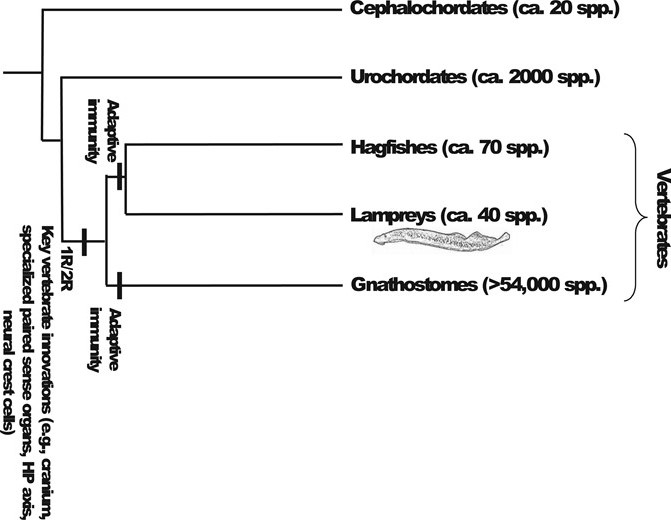Lamprey is one of the extant representatives of the jawless vertebrates, more than 500 million years old and known as a "living fossil". The life cycle of the lamprey is divided into three stages: larval, metamorphic, and adult. The ancient lamprey has attracted the attention of many scholars due to its unique functional characteristics and evolutionary status.
 Figure 1. The whole lamprey.
Figure 1. The whole lamprey.
The importance of studying lamprey
 Figure 2. The interrelationships among the vertebrate lineages (jawless hagfishes and lampreys, as well as jawed vertebrates) and the nonvertebrate chordates (cephalochordates and urochordates) were inferred from molecular data. (David WM,et al. 2015)
Figure 2. The interrelationships among the vertebrate lineages (jawless hagfishes and lampreys, as well as jawed vertebrates) and the nonvertebrate chordates (cephalochordates and urochordates) were inferred from molecular data. (David WM,et al. 2015)
CRISPR/Cas9 technology services
The lamprey has a variety of characteristics that make it well suited for CRISPR/Cas9-based gene manipulation. Like amphibian embryos, which are easy to inject and can tolerate large amounts of synthetic RNA and protein. Having more Cas9 protein and gRNA per cell not only increases mutagenesis efficiency but also offers the possibility of mutating multiple genes at the same time. Therefore, Lifeasible recommend that you choose our CRISPR/Cas9 gene-editing technology service to study specific genes in lamprey.

Morpholinos technology services
Morpholinos are synthetic oligonucleotides that target the expression of specific RNA transcripts to block the expression and activity of specific proteins. Lifeasible can be combined within in situ hybridization techniques to analyze changes in lamprey gene expression caused by morpholinos-induced downregulation of gene expression.
RNAi technology services
RNAi is an endogenous post-transcriptional regulatory mechanism that silences specific mRNA transcripts and plays an important role in regulating development and cellular defense against foreign DNA. Lifeasible can utilize RNAi technology as a tool to study the role of specific genes in lamprey, and our technical services provide an important approach to study the mechanisms of lamprey development and disease.
The lamprey takes 7-15 years to mature, can grow to nearly 1 m in length, and requires large live prey as an adult. Therefore, it is practically impossible to establish mutant or transgenic lines of this species. However, for specific gene studies, Lifeasible can offer a variety of options for clients to choose from to complete gene editing experiments such as gene knockout, all of these methods can be used to study the underlying mechanisms of lamprey development.
References